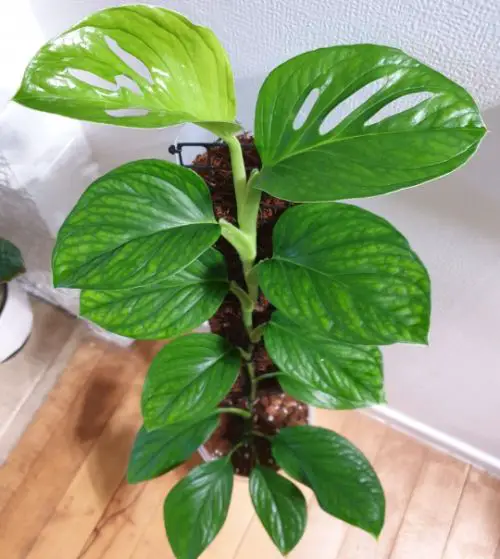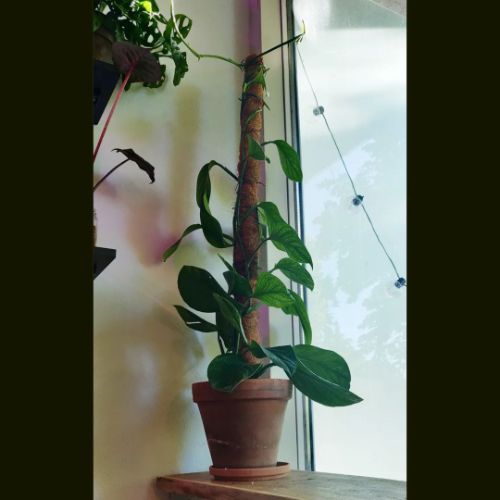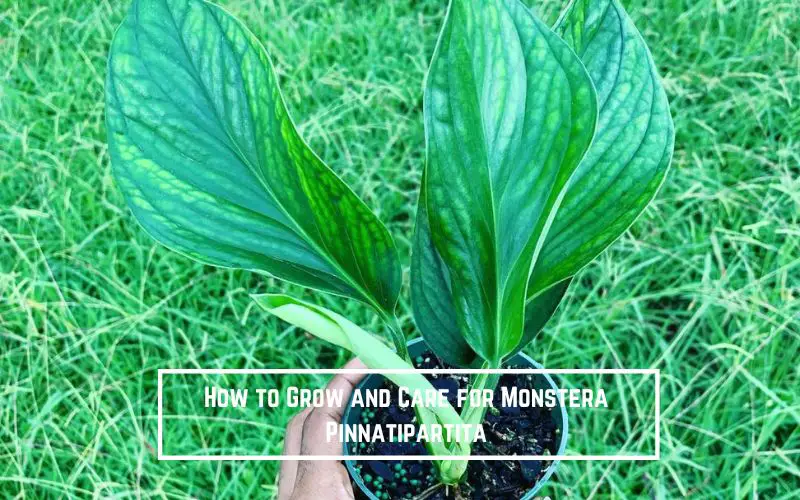Looking for a lush and tropical houseplant that is easy to care for? Look no further than Monstera Pinnatipartita! This beautiful plant can be grown indoors or outdoors and is perfect for those who are new to gardening. In this blog post, we will discuss how to grow and Monstera Pinnatipartita care. We will also provide tips on how to keep your plant healthy and thriving
Monstera Pinnatipartita care guide
If you’ve ever cared for another aroid, Monstera, or even a tropical plant, you already have a lot of the information needed to develop a healthy Monstera Pinnatipartita!
Soil
Monstera Pinnatipartita grows above ground as an epiphyte, crawling over another tree and growing without roots in the soil, receiving nutrients from the air, organic materials, decaying plants, and animal excrement.
It goes without saying that a soil mixture with lots of organic matter, such as mulch, compost, bark fragments, and, if you can get your hands on it, organic manure based on animal dung, is best for growing Monstera Pinnatipartita.
A volume of about 50% is ideal. Ideal potting soil with perlite and sand should make up the remaining 50%.
If you want to grow Monstera Pinnatipartita and not kill it, the soil must be able to hold moisture while still being incredibly well-draining.
Anthurium is a floral species that is quite similar to this plant.
A nice Anthurium potting soil mix that is readily accessible in stores is a fantastic care hack for Monstera Pinnatipartita.

Light
These rainforest plants are used to the dispersed sunlight found beneath the forest canopy. The finest light for your Monstera Pinnatipartita will come from an east-facing window. Place the plant far enough away from a south or west-facing window to get plenty of light but not direct sunshine throughout the day or late afternoon when the sun is at its hottest.
Because of its low light tolerance, you can basically grow Monstera Pinnatipartita wherever in your house, but it will grow more slowly and develop darker leaves if there is too little light. Leaf growth may also be slower and more sporadic in low-light conditions.
If a north-facing window is insufficient for the growth of your Monstera Pinnatipartita, a full-spectrum grow light can be employed as a backup. (For normal light fixtures, we suggest these screw-in grow bulbs.) If you want to utilize grow lights, give your plants at least 8 hours of this high light every day. Read the article Best Grow Lights For Monstera to choose the right lights for your house plant

Watering
The soil must be kept damp but not wet in order to properly cultivate Monstera Pinnatipartita.
Watering is frequently advised when the soil is almost entirely dry. But in my experience, factors like temperature, humidity, the amount of light a plant receives, its size, etc. all affect how much water a plant needs.
Acclimating it has proven to be a successful care method for Monstera Pinnatipartita. So, until the plant adjusts to the regimen, you essentially water once each week.
Reduce the watering for a few weeks if you notice fading leaves. then get back to water as usual.
As long as a suitable amount of water is applied, the plant appears to grow well.
Additionally, whenever you do anything, especially if you’re feeding the plant, water well until the water runs out of the drainage holes.
Humidity
Humidity is a “good to have” component of Monstera Pinnatipartita care because these plants are native to areas with moderate to high levels of humidity. Although 60% humidity is optimal if you can manage it, your Monstera Pinnatipartita will grow in humidity levels above 50%.
If you live in a dry environment or often utilize indoor temperature control, you should probably try to enhance the ambient humidity surrounding your Monstera. Place the plant in a humidity tray or place a humidifier nearby. Plants in close proximity can raise local humidity levels due to their shared respiration. Tropical plants look great in a humid, bright bathroom if you have the space.
Finally, if you place your plant too close to air conditioning or heating vents, they may blow dry air upon it, crisping the leaves!
Temperature
Although the plant prefers warm weather, you might say that it is fairly cool-resistant. The temperature must be at least 50oF (10°C), but never lower.
In spite of this, Monstera Pinnatipartita grows best in climates with annual average temperatures of 65 to 80 °F (18 to 27 °C).
At 65°F (18°C), the plant begins to actively grow, and it stops growing entirely at 50°F (10°C).
If you’re keeping this plant inside, keep the environment at a comfortable temperature.
Only robust climate zones where temperatures rarely fall below 50oF (10°C) are suitable for outdoor cultivation. The plant is vulnerable to frost because it is tropical.
Fertilization
Use a mild liquid fertilizer on a frequent basis when your Monstera is most likely to be actively growing, which is in the spring and summer.
Decomposed organic material added to the soil serves as organic sustenance for the plant that releases slowly over time. A larger, healthier plant will result from fertilizing it with a balanced 20-20-20 or 20-10-10 fertilizer, which increases leaf size.
A well-diluted fish emulsion given every 4 to 6 weeks offers it a significant springtime boost. Keep in mind to reduce the plant’s feeding throughout the winter months so that it may rest.
Once the plant reaches maturity, I recommend fertilizing it every two months with a balanced orchid or anthurium fertilizer, which you can purchase at your neighborhood store.
This should only be used during the growing season and is solely intended to increase blooms.
Potting
Growing Monstera Pinnatipartita as a climber rather than a trailing vine is suggested.
It should be grown in a large pot with a moss-covered pole, a piece of wood, or some type of trellis to allow the stems to climb.
The plant is supported by long, hanging aerial roots that the stems transmit down.
Because the roots prefer air, keep the soil loose and the container spacious.
Unlike other epiphytes, this does not have to be root bound.
Monstera Pinnatipartita care need a solid base because to its top-heavy nature.

Growth
Due to its quirks in growing, Monstera Pinnatipartita is generally easier to care for indoors. It continues to grow tall rather than wide, and the leaves are still of ordinary size.
Contrary to other Monstera kinds, this one’s internodes are hardly noticeable, which makes it intriguing.
It’s a sluggish creeper that works well for indoor gardening since the emerald green leaf petioles seem to be packed extremely closely on top of one another.
For an even more impressive effect, grow Monstera Pinnatipartita outside in the ground and allow it to climb up a corner wall.
If you’re lucky, you could catch a glimpse of its stunning monocot pure white waxy blooms with a spathe and spadix, which are typical of all plants in the arum family, Araceae. This causes the leaves to become totally split or pinnate.
Just watch out for direct sunlight to prevent sunburn. In its natural environment, the plant can reach heights of up to 33-66′ (10-20m) in its search for sunshine, frequently losing contact with the earth in the process.
Monstera Pinnatipartita propagation Method
Propagation by stem cuttings
Propagation by stem cuttings is the most common method used to propagate Monstera Pinatipartita. Cuttings can be taken from young, growing tips or from more mature stems. It is important to use a sharp knife or pair of scissors to take the cuttings, as this will help to prevent infection and healing time.
- Choose a mature stem tip from a mother plant with visible aerial roots
- Trim the stem tip using garden scissors to include at least two leaf nodes
- Pinch the leaves of the lowest node
- Maintain a container that is uniformly extremely moist but not dripping wet with a 50/50 blend of perlite and sphagnum moss
- Because the cuttings normally root effectively, there is no need for a rooting hormone
- Push the dirt down for support and bury at least one node well below the surface
- Keep the pot out of direct sunlight yet in a bright location
- Keep the soil wet until the cutting has taken root. It should take one to two weeks. After eight weeks, move it to regular potting soil
Propagate Monstera pinnatipartita in water
- Up to step 3, follow the instructions in the preceding section
- Choose a jar with an aperture at least 3 inches wide and only deep enough to immerse the cutting’s nodes while leaving the terminal leaves exposed to air
- Pro tip: If the entrance of the jar is too small, the roots will break when you remove the cutting
- Put your cut in a clean, water-filled container
- Do not interfere with the cutting; be in a place with indirect sunlight
- The nodes submerged in water will begin to grow new roots after one to two weeks
- Plant the cutting in the ground when the roots are approximately an inch or two long. After eight weeks, move it to regular potting soil
Propagate Monstera Pinnatipartite by Air layering
A 6″ transparent plastic bag, some twist ties, and sphagnum moss are required.
- Choose a node, leggy node with aerial roots. Right under that node, cut a small incision that is no deeper than 1/4th the thickness of the stem.
- Make a few tiny holes in the bottom of the plastic bag, then stuff it with a handful of uniformly damp sphagnum moss. Cut the plastic bag’s top end so that there are flaps to roll around the stem.
- Let’s go on to the plant now. Hold the plastic bag of wet moss against the chosen aerial root node with one hand. Wrap the plastic flaps around the stem with your free hand. With the help of twisty ties, attach this bag of moist moss to the stem, creating a cozy cocoon for the node.
- By watering through the perforations in the plastic, you can keep the moss damp.
- You’ll see that the roots have gotten into the moss after two weeks.
- Cut the stem below the new roots to separate the cutting from the mother, then remove the moss without damaging your new roots.
- Until the new plant is well-established, pot it and keep the soil wet.
- Pro tip: Do this for many nodes at once to increase your chances of success and ensure that at least one of them takes root.
You may also like: How to propagate Monstera – 1001 tips keeping it healthier
Common Problems with Monstera Pinnatipartita care
1. Overwatering
One of the most common problems with Monstera Pinnatipartita care is overwatering. This can lead to root rot, which can eventually kill the plant. It is important to water Monstera Pinnatipartita only when the soil is dry to the touch, and to make sure that the plant has good drainage. To read more about overwatering Monstera, please check out this blog https://dignursery.com/overwatered-monstera/.
2. Poor Lighting
Monstera Pinnatipartita need bright, indirect light in order to thrive. If they do not get enough light, they will start to stretch and become leggy. However, too much direct sunlight can scorch their leaves.
3. Nutrient Deficiencies
Monstera Pinnatipartita are susceptible to nutrient deficiencies, particularly if they are not getting enough nitrogen. This can cause the leaves to turn yellow and may eventually lead to leaf drop. A balanced fertilizer should be applied every few weeks to prevent this from happening.
4. Pests
Monstera Pinnatipartita are prone to infestations of mealybugs, spider mites, and scale. These pests can cause damage to the leaves and may eventually kill the plant if left unchecked. Regularly inspecting your plant for signs of pests is the best way to prevent an infestation from occurring.
5. Diseases
Monstera Pinnatipartita are susceptible to a few different diseases, the most common of which is root rot. This can be caused by overwatering or by having poorly draining soil. If you think your plant has root rot, it is important to remove it from the pot and replant it in fresh, well-draining soil as soon as possible.
Tip to care Monstera pinnatipartita
- Water Monstera Pinnatipartita only when the soil is dry to the touch
- Place Monstera Pinnatipartita in an area that receives bright, indirect light
- Apply a balanced fertilizer every few weeks to prevent nutrient deficiencies
- Inspect your plant regularly for signs of pests and diseases
- Remove any affected leaves or stems from the plant immediately
- The leaves of the Monstera Pinnatipartita may turn to face the sun. Therefore, an excellent strategy to ensure healthy development is to occasionally turn the pot around so that the plant’s exposed side receives sunlight
Monstera Pinnatipartita care Frequently Asked Questions
How often should I water my Monstera Pinnatipartita?
Water your Monstera Pinnatipartita when the top inch of soil feels dry to the touch. Allow the plant to drain fully after watering.
What type of light does a Monstera Pinnatipartita need?
Monstera Pinnatipartita prefers bright, indirect light but can tolerate lower light conditions.
What is the best way to propagate a Monstera Pinnatipartita?
Propagate Monstera Pinnatipartita by rooting stem cuttings in water or moist potting mix.
Is Monstera Pinnatipartita poisonous?
Monstera Pinnatipartita is not poisonous. However, the sap from the plant can cause irritation if it comes into contact with the skin. If ingested, the sap may cause stomach upset.
Can Monstera Pinnatipartita live in water?
No, Monstera Pinnatipartita cannot live in water. The plant prefers to grow in moist, well-drained soil.
My Monstera Pinnatipartita has brown leaves, what does this mean?
If the leaves of your Monstera Pinnatipartita are turning brown, it is likely due to too much direct sunlight or excessive humidity. Brown leaves can also be a sign of drought stress or nutrient deficiency.
How often should I fertilize my Monstera Pinnatipartita?
Fertilize your Monstera Pinnatipartita every two weeks during the growing season and monthly during the winter. Use a balanced fertilizer formulated for houseplants.
What is the natural habitat of Monstera Pinnatipartita?
Monstera Pinnatipartita is native to the tropical rainforests of Central and South America.
Monstera Pinnatipartita is a beautiful and exotic plant that can be a great addition to any home. With a little bit of TLC, your Monstera will thrive for years to come. Be sure to follow our soil, light, water, temperature, humidity, growth and fertilization tips in order to keep your plant looking its best.


